“Mounted Lancer” has been added to your cart.
View cart
-
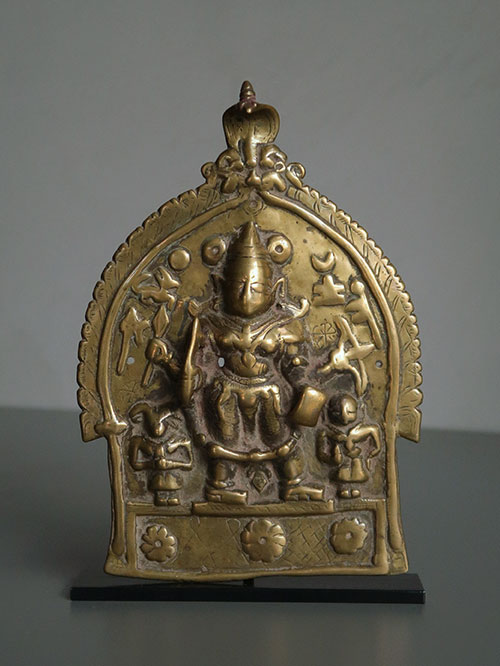
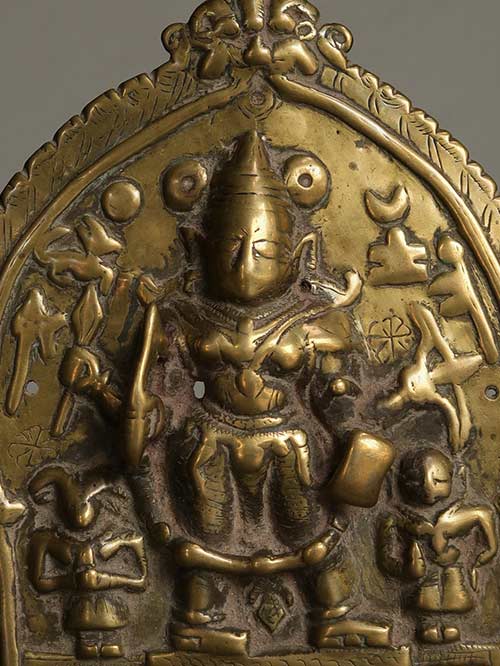
Karnataka
brass alloy
A fine brass repousse plaque. The central standing figure of Virabhadra is flanked by the diminutive figures of Bhadrakali and the goat headed Daksha. He is shown with fours arms in which he carries his usual attributes of bow, arrow, sword and shield. He wears a tall crown, a collar, two necklaces and sandals. A garland of skulls decorates the bottom of his dhoti (loincloth). The figures are placed within an arch or prabhavali at the centre of which is a kirtimukha (face of glory). A naga (serpent) forms a canopy above Virabhadra’s head. Symbols of the sun, moon, nandi and lingam are depicted on the plaque. This deity is a form of Shiva who created him to act as his henchman in his quarrel with Daksha. Virabhadra is worshipped especially in southern Maharashtra and Karnataka.
Size (cms): 24 (H) x 16 (W)
Size (inches): 9.5 (H) x 6.5 (W)
-
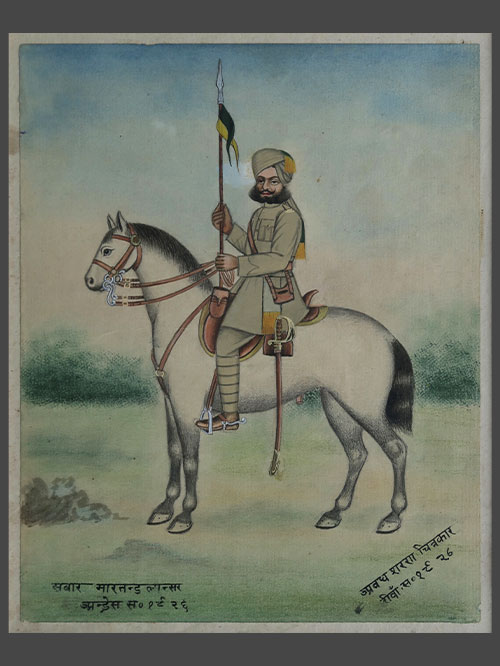
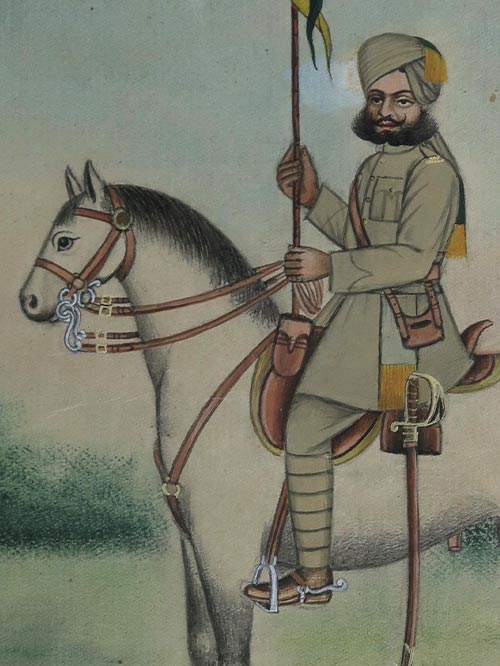
Rewa (Central India)
pigments on paper
Company Painting, Signed by the artist Avadh Sharan
A charming Company painting of a lancer captioned, “Rider Maartand Lancer.” Originally bound in an album. Lancers were a type of cavalryman who fought with lances, a pole weapon similar to a spike or spear. The first armoured troops in India were formed in 1914. In 1921, the Indian Army cavalry regiments were reorganised, and consolidated into twenty-one regiments. During this period, the Indian army was a separate organisation to the British Army. The main task of the Indian Army was to police the Indian Empire. During the first and second world wars, Indian troops served with distinction in France in 1940, Egypt, Libya, the Sudan, Abyssinia, Syria, Persia, Iraq, Malaya and Burma.
‘Company’ is a designation given to works by Indian artists painted in a mixed Indo-European style for the various East India companies. The foundation of this Indo-European style can be traced to the establishment of the first Portuguese trading posts. The British only counted as patrons in the 1760s following Clive’s victory at Plassey in 1757 . Patronage by the British in effect followed the flag. Princely states never directly under British control produced little company art and important centres like Delhi and Agra only became so after the British stabilised the reason in the early 1800s. Photography gradually replaced the genre in the 1840s but the style lingered on until the late nineteenth century. Barring minor regional variations, Company Style took the same form in all the centres. The favourite subjects were trades, costumes, crafts and festivals. Also popular were topographical pictures of contemporary India and exotic flora and fauna.
Painting Size (cms): 22 (H) x 18 (W)
Painting Size (inch): 8.5 (H) x 7 (L)
Framed Size (cms): 36.5 (H) x 32 (W)
Framed Size (inch): 14.5 (H) x 12.5 (L)
-
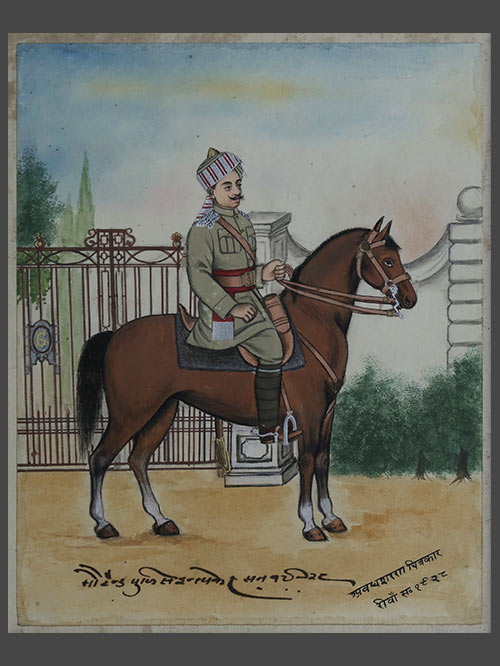

Rewa (Central India)
pigments on paper
Company Painting, Signed by the artist Avadh Sharan
A charming Company painting of a mounted Police Officer from Rewa in Central India. Unusually the painting is signed by the artist Avadh Sharan and also dated 1928. Originally bound in an album.
‘Company’ is a designation given to works by Indian artists painted in a mixed Indo-European style for the various East India companies. The foundation of this Indo-European style can be traced to the establishment of the first Portuguese trading posts. The British only counted as patrons in the 1760s following Clive’s victory at Plassey in 1757 . Patronage by the British in effect followed the flag. Princely states never directly under British control produced little company art and important centres like Delhi and Agra only became so after the British stabilised the reason in the early 1800s. Photography gradually replaced the genre in the 1840s but the style lingered on until the late nineteenth century. Barring minor regional variations, Company Style took the same form in all the centres. The favourite subjects were trades, costumes, crafts and festivals. Also popular were topographical pictures of contemporary India and exotic flora and fauna.
Painting Size (cms): 22 (H) x 18 (W)
Painting Size (inch): 8.5 (H) x 7 (L)
Framed Size (cms): 36.5 (H) x 32 (W)
Framed Size (inch): 14.5 (H) x 12.5 (L)
-
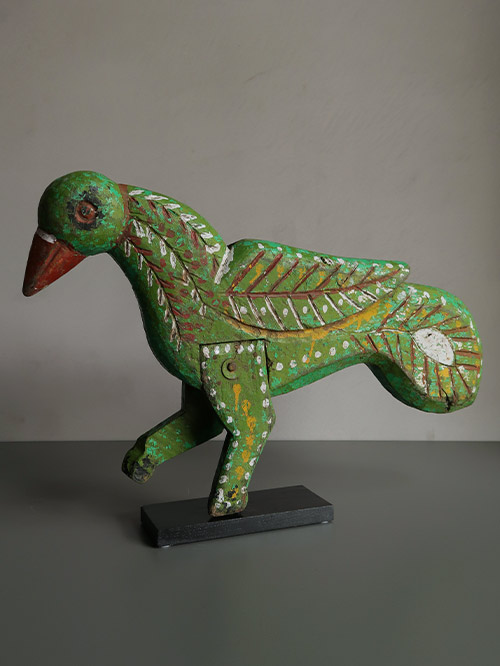
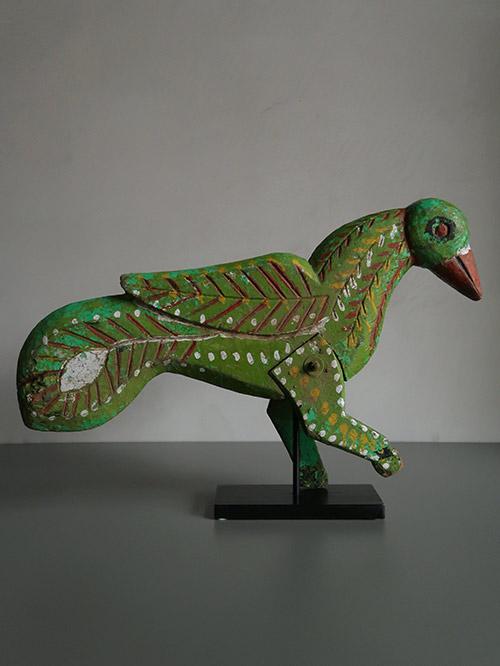
Maharashtra/Karnataka
Wood polychromed
An attractive folk carousel animal in the shape of a parrot with original polychroming. The parrot is the vehicle (vahana) of Kama – the god of love. Generally depicted riding on a parrot, Kama is depicted armed with a bow made of sugar cane (ikshukodanda) bearing a string formed by a row of buzzing bees, five flowertipped arrows, symbolizing the five senses, and on his banner the Makara, an aquatic monster.
Size (cms): 47.5(H) x 70(W) x 10(D)
Size (inches): 18.5(H) x 27.5(W) x 4(D)









